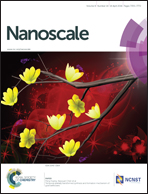Metal nanoparticles triggered persistent negative photoconductivity in silk protein hydrogels
Abstract
Silk protein is a natural biopolymer with intriguing properties, which are attractive for next generation bio-integrated electronic and photonic devices. Here, we demonstrate the negative photoconductive response of Bombyx mori silk protein fibroin hydrogels, triggered by Au nanoparticles. The room temperature electrical conductivity of Au–silk hydrogels is found to be enhanced with the incorporation of Au nanoparticles over the control sample, due to the increased charge transporting networks within the hydrogel. Au–silk lateral photoconductor devices show a unique negative photoconductive response under an illumination of 325 nm, with excitation energy higher than the characteristic metal plasmon resonance band. The enhanced photoconductance yield in the hydrogels over the silk protein is attributed to the photo-oxidation of amino groups in the β-pleated sheets of the silk around the Au nanoparticles followed by the breaking of charge transport networks. The Au–silk nanocomposite does not show any photoresponse under visible illumination because of the localization of excited charges in Au nanoparticles. The negative photoconductive response of hybrid Au–silk under UV illumination may pave the way towards the utilization of silk for future bio-photonic devices using metal nanoparticle platforms.


 Please wait while we load your content...
Please wait while we load your content...